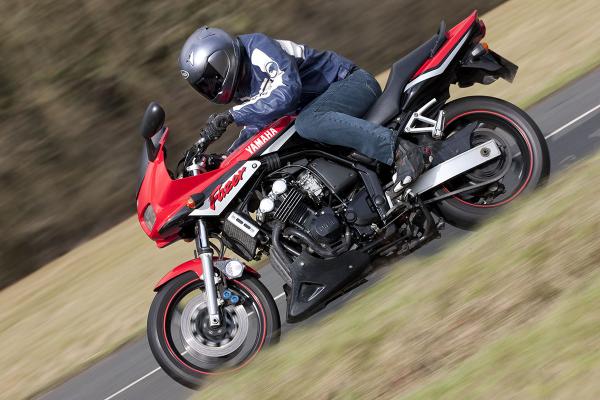
By Simon Hargreaves
EVERYONE likes to spot a something new before anyone else; an undiscovered band or a house price collapse or a tsunami.
Predicting which from the vast panoply of new motorbikes will become a future classic and which will be consigned to gather dust in the dealership in the sky is a tricky business (otherwise known as ‘guesswork’). Especially if you’re speculating to accumulate rather than just idly speculating. The general rule is there’s only one general rule: given sufficient time, almost any bike kept in mint condition becomes collectable in the end. Even CX500s. You just have to wait until there aren’t any ropey ones left and everyone’s forgotten about bad they were in the first place.
1) Yamaha FZS600 Fazer
Some things are so ubiquitous we fail to realise what design classics they are until they’ve been recycled into oblivion and/or turned into landfill, whereupon we suffer a collective nostalgic guilt at the scorched earth excess of unrestrained consumerism. We’re thinking any die-cast Corgi toy, Raleigh Choppers and MkIII Ford Cortinas (allegedly Britain’s second-most scrapped car; the Morris Marina is first).
Yamaha’s friendly, funky Thundercat-powered FZS600 Fazer (pictured above) was the two-wheeled MkIII Cortina of 1998. It blended utility and irrepressible enthusiasm in a handsome package. Everyone loved it and it loved everyone. Thus they were everywhere (combined with the later, R6-powered FZ6, the middleweight Fazers are the fourth most numerous bikes on UK roads according to the DVLA).
Today, many Fazers are gently decaying in budget used bike yards or falling into the hands of serial corroders who can rot a header at 20 paces just by looking at it. Before the decade is out the current supply of clean, low milers at around the grand mark will have dried up and all you’ll get is, basically, a pile of rust for £500. A bit like 600 Diversions are now. And soon after that we’ll all wish we had the perky chap in the corner of our garage. Buy one while you can.
Way overpriced for dealers and punters when it was launched: £9349, which was a lot in 2005 (plus dealers had to pay Yamaha a couple of grand for display stands so they weren’t over-keen on the bike from the off). And within a few years the asking had climbed north of ten grand, which is bonkers.
But so’s the bike. The motor is a pushrod, aircooled 1670cc V-twin nicked from the Road Warrior cruiser, making more torque than power (110 ft.lb and 90bhp) and peak power at 4500rpm. Yet the chassis is based on the R1 with fully adjustable usd forks and rear shock, swingarm and radial brakes. It’s a proper collision of old v new.
And yes, it’s nuts. With concrete-breaking combustion blows it’s like riding a Kango hammer and the harder you rev it, the slower it goes. What it really needs is to thud about at 3000rpm, where it turns out it’s actually fairly rapid. And it goes round corners too, provided the tank range lasts long enough to get you there (it’s 15 litres and a 100 miles). And it looks like it was chiseled from concrete.
No-one will ever make anything like the MT-01 again (not even Moto Guzzi), which is why its future value lies in its novelty. In 20 years’ time no-one will believe it ever existed.
An instant, guaranteed-with-knobs-on, classic. Not the new ones or the Rs – keep an original, gold, 675 under a blanket and it’ll reward you when you retire (providing you’re not already in your late 50s). Triumph’s slow turnover of new models means it’ll take a while before everyone’s forgotten how good looking the first Daytona was. But it was. Skeletal, minimal, slightly shonky but shot through with an unmistakable genius that perfectly captures the moment a manufacturer hit its stride. And it also signifies the moment in the mid Noughties when we realised the Japanese had lost the plot.
If the 2006 675 represents the rebirth of the European bike industry, the 2005 GSX-R1000 K5 represents the high point of the Japanese bike industry because it hasn’t got any better than this since. The later K7 and onwards got heavier as emissions regs weighed down exhausts (have you felt the weight of a modern Japanese exhaust system?), and Japanese manufacturers entered a race for the bottom in terms of build quality.
It leaves the K5 and 6 as the perfect combination of power, weight and pure engineering. And it’s worth salting one away not so much as an investment, but just to remind yourself what litre sportsbikes bikes felt like before emissions, electronics, and everyone got too old anyway.
It’s an RC36, which means it’s six better than an RC30. It was built when Honda knew what build quality meant. It looks like an NR750. It’s got gear-driven cams. It feels like riding on butter. The V4 is a distillation of Soichiro’s soul. It was, still is, and, if you buy one now and look after it, will always be, the most complete all-round motorcycle ever created.
Forget the original – it’s already a classic and is reflected in prices (I recently tried to haggle a mint 7000-mile 1996 Blade down from the £3500 asking to a more reasonable £2k, but the seller wasn’t having it).
Instead, look to the fuel injected Blades – not the 2000 - 2002 929 which was finicky and fussy, but the 2002 - 2003 954 which benefitted from a larger motor giving more flexibility and various chassis and styling improvements which perfected the bike. It’s small, compact, well put together and, because it was only made for a couple of years, the ‘forgotten’ Blade. Coupled with the fact it’s a really, really effective tool, it’ll be due a reassessment and market reevaluation (with will see prices climb) in… oooh… another ten years.
See MT-01: another bizarre, overpriced, concept-bike-inspired mix of engine and chassis – this time with a Hayabusa motor and styling like a Transformers wet dream. Ludicrous megaphone exhaust cans aside, the bike is brilliant: unbelievable grunt, a capable chassis and even the riding position is relatively sane. Like the Yamaha, the B-King was gently mocked, then ignored. When we’re all bored with NC700s (which hopefully won’t take long), the B-King’s time will come.
No, really. Launched to vast swathes of indifference in the UK, the Z750 established itself as a best-seller in France where its simplicity and, above all, low price was a stylish, cost-conscious solution for banzai Parisian commuters. Of whom there are many. Basically a sleeved-down Z1000 with the same engine and chassis but cheapo suspension and single exhaust can instead of the Z Thou’s quad pipes, the 750 was distinctly ordinary.
But that’s sometimes the thing with the double-take of nostalgia: ordinary + time = extraordinary. When everyone’s forgotten what a useful little bike the Z750 was; how it was actually good looking in a plain kind of way, and how what seems like an underpowered 100bhp engine back in the day now seems like the right amount of power to get around on, the Z750 will make a comeback. And it’ll be too late – all that’ll be left will be a couple of zillion-mile ex-French hacks smelling of onions. You have been warned.
What do you do when you’ve built a 90s icon? You balls it up in the Noughties. At least that’s what everyone thought when they saw the 999 after the 916. The 999 was the only thing it could be: not as pretty (although it could’ve been an MV Agusta F4 750; if the 999 had looked like that, Ducati wouldn’t have spent the decade building the 1098 as an apology).
It wasn’t a bad machine. The 999 was, and remains, Ducati’s most winning-est race bike. And its looks have grown. No longer an angular jumble of lines and flat panels, today the 999 is considered a bit tasty and the 916’s ‘classic’ ship has well and truly sailed; prices are high as every man and his pet hamster jump on and buy up even mongrel 916s for silly money.
999. Not just for emergencies.
They’re already classics, aren’t they?
A version of this article was first published in 2013.

